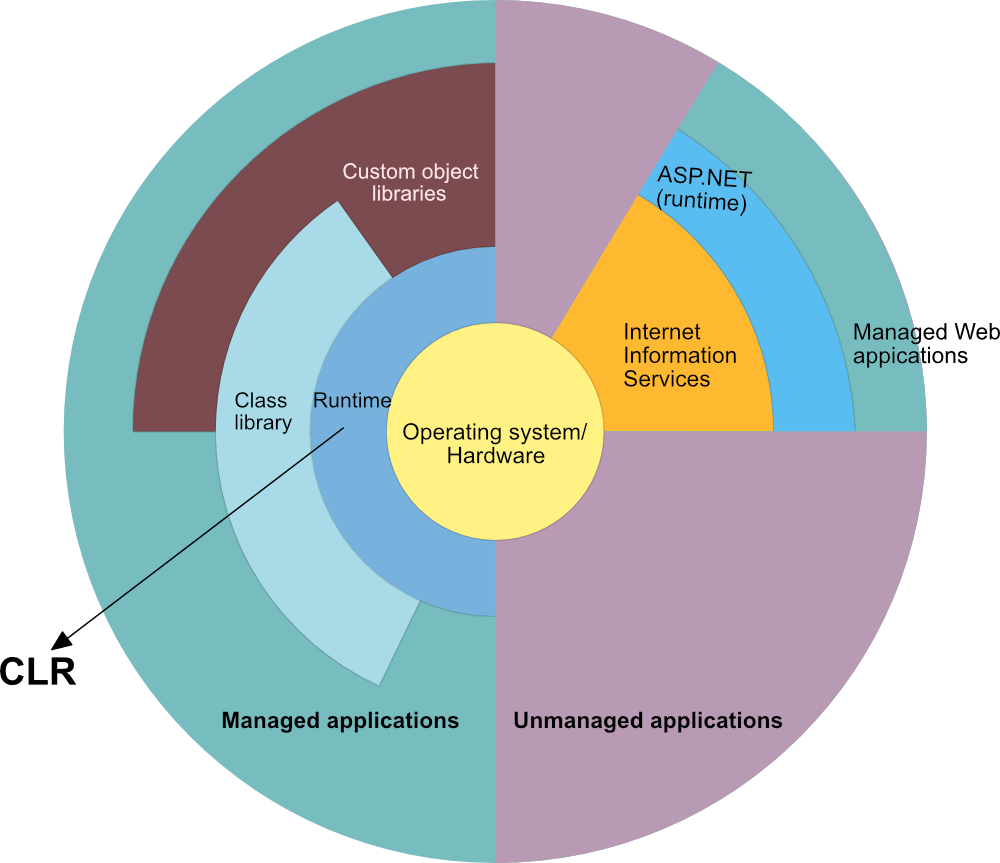Role of CLR in the execution of a C# program
- Suppose you have written a C# program and save it in a file which is known as the Source Code.
- Language specific compiler compiles the source code into the MSIL(Microsoft Intermediate Language) which is also know as the CIL(Common Intermediate Language) or IL(Intermediate Language) along with its metadata. Metadata includes the all the types, actual implementation of each function of the program. MSIL is machine independent code.
- Now CLR comes into existence. CLR provides the services and runtime environment to the MSIL code. Internally CLR includes the JIT(Just-In-Time) compiler which converts the MSIL code to machine code which further executed by CPU. CLR also uses the .NET Framework class libraries. Metadata provides information about the programming language, environment, version, and class libraries to the CLR by which CLR handles the MSIL code. As CLR is common so it allows an instance of a class that written in a different language to call a method of the class which written in another language.
- Suppose you have written a C# program and save it in a file which is known as the Source Code.
- Language specific compiler compiles the source code into the MSIL(Microsoft Intermediate Language) which is also know as the CIL(Common Intermediate Language) or IL(Intermediate Language) along with its metadata. Metadata includes the all the types, actual implementation of each function of the program. MSIL is machine independent code.
- Now CLR comes into existence. CLR provides the services and runtime environment to the MSIL code. Internally CLR includes the JIT(Just-In-Time) compiler which converts the MSIL code to machine code which further executed by CPU. CLR also uses the .NET Framework class libraries. Metadata provides information about the programming language, environment, version, and class libraries to the CLR by which CLR handles the MSIL code. As CLR is common so it allows an instance of a class that written in a different language to call a method of the class which written in another language.
- Managed Code: The MSIL code which is managed by the CLR is known as the Managed Code. For managed code CLR provides three .NET facilities:
- Unmanaged Code: Before .NET development the programming language like .COM Components & Win32 API do not generate the MSIL code. So these are not managed by CLR rather managed by Operating System which is called unmanaged code.
- Value Types: Value Types will directly store the value directly into the memory location. These types work with stack mechanism only. CLR allots memory for these at Compile Time.
- Reference Types: Reference Types will contain a memory address of value because the reference types won’t store the variable value directly in memory. These types work with Heap mechanism. CLR allots memory for these at Runtime.
- It improves the performance by providing a richly interact between programs at the run time.
- Enhance portability by removing the need of recompiling a program on any operating system that supports it.
- Security also increases as it analyzes the MSIL instructions whether they are safe or unsafe. Also, the use of delegates in place of function pointers enhance the type safety and security.
- Support automatic memory management with the help of Garbage Collector.
- Provides cross-language integration because CTS inside CLR provides a common standard that activates the different languages to extend and share each other’s libraries.
- Provides support to use the components that developed in other .NET programming languages.
- Provide language, platform, and architecture independency.
- It allows the creation of the scalable and multithreaded applications in an easier way as a developer has no need to think about the memory management and security issues.
- Managed Code: The MSIL code which is managed by the CLR is known as the Managed Code. For managed code CLR provides three .NET facilities:
- Unmanaged Code: Before .NET development the programming language like .COM Components & Win32 API do not generate the MSIL code. So these are not managed by CLR rather managed by Operating System which is called unmanaged code.
- Value Types: Value Types will directly store the value directly into the memory location. These types work with stack mechanism only. CLR allots memory for these at Compile Time.
- Reference Types: Reference Types will contain a memory address of value because the reference types won’t store the variable value directly in memory. These types work with Heap mechanism. CLR allots memory for these at Runtime.
- It improves the performance by providing a richly interact between programs at the run time.
- Enhance portability by removing the need of recompiling a program on any operating system that supports it.
- Security also increases as it analyzes the MSIL instructions whether they are safe or unsafe. Also, the use of delegates in place of function pointers enhance the type safety and security.
- Support automatic memory management with the help of Garbage Collector.
- Provides cross-language integration because CTS inside CLR provides a common standard that activates the different languages to extend and share each other’s libraries.
- Provides support to use the components that developed in other .NET programming languages.
- Provide language, platform, and architecture independency.
- It allows the creation of the scalable and multithreaded applications in an easier way as a developer has no need to think about the memory management and security issues.












0 comments:
Post a Comment